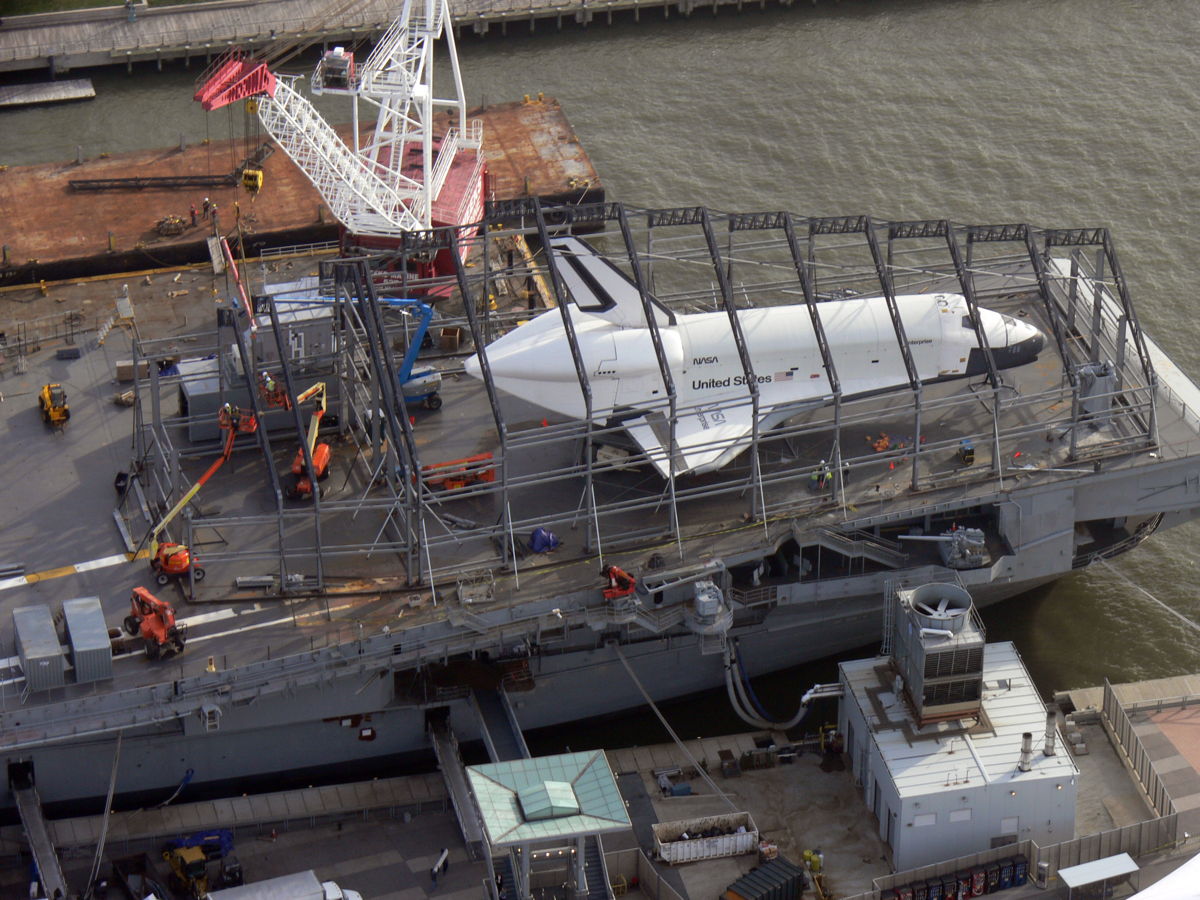Space Shuttle Enterprise's New Home Takes Shape at NYC Museum

Space shuttle Enterprise, NASA's test orbiter destined for display in New York City, will soon have a new home.
As aerial photographs taken Friday (April 26) show, the construction of a new exhibition pavilion is taking shape above and around the prototype space shuttle, which arrived on the flight deck of the Intrepid, Sea, Air & Space Museum, a converted World War II aircraft carrier docked on Manhattan's west side, one year ago this month.
"The one-year anniversary of Enterprise's arrival in New York City was an exciting milestone for the museum and everyone whose imagination is captured by manned space flight," a spokesperson for the Intrepid said in a statement provided to collectSPACE.com. "We are currently completing the framework of the new Space Shuttle Pavilion that will serve as the home to the Enterprise exhibit." [See photos of space shuttle Enterprise in NYC]
"We will soon be installing the outer skin of the structure, then completing the interior, in time for the opening this summer," the spokesperson said.
Enterprise, which did not fly in space but was used for a piloted approach and landing tests in 1977, touched down on April 27, 2012, at John F. Kennedy International Airport mounted atop a NASA jumbo jet. The orbiter was then transported by barge to the Intrepid just over a month later and opened for public display in July.
A short three months later, Hurricane Sandy tore through New York City, completely destroying the Intrepid's Space Shuttle Pavilion, a pressurized structure that sheltered Enterprise. The superstorm also caused minor damage to the shuttle's vertical stabilizer, or tail.
Repairs to the orbiter were finished in March, when the temporary covered scaffolding surrounding Enterprise was taken down.
Get the Space.com Newsletter
Breaking space news, the latest updates on rocket launches, skywatching events and more!
As WCBS 880's traffic reporter Tom Kaminski captured in his aerial photographs, the new pavilion relies on a metal skeleton, rather than air pressure, to maintain its shape. When the storm hit last October, the previous pressurized structure deflated as a result of its primary power source and backup generators being flooded.
According to the Intrepid, the same Weeks Marine barge-mounted crane that was used to hoist Enterprise onto the flight deck last year is now being used to construct the new pavilion, which is about the same size as the original display structure.
Since receiving space shuttle Enterprise from NASA and the Smithsonian — the latter had the orbiter on display at the Steven F. Udvar-Hazy Center, the Virginia annex to the National Air and Space Museum, until space shuttle Discovery took its place in April 2012 — the Intrepid has applied for and received National Historic Place status for the test orbiter.
The museum also launched a dedicated artifacts exhibit, "Space Shuttle Enterprise: A Pioneer," to educate visitors about the history of the prototype spacecraft while its new pavilion is still under construction. The exhibition includes a crowd-sourced photo display of Enterprise's journey to New York City and the Intrepid, which documents in part the rise, fall and rise again of the space shuttle's home on board the aircraft carrier.
Click through to collectSPACE.com to see more aerial photographs of space shuttle Enterprise as its new pavilion takes shape aboard the Intrepid Sea, Air & Space Museum.
Follow collectSPACE.com on Facebook and on Twitter at @collectSPACE. Copyright 2013 collectSPACE.com. All rights reserved.
Join our Space Forums to keep talking space on the latest missions, night sky and more! And if you have a news tip, correction or comment, let us know at: community@space.com.

Robert Pearlman is a space historian, journalist and the founder and editor of collectSPACE.com, a daily news publication and community devoted to space history with a particular focus on how and where space exploration intersects with pop culture. Pearlman is also a contributing writer for Space.com and co-author of "Space Stations: The Art, Science, and Reality of Working in Space” published by Smithsonian Books in 2018.In 2009, he was inducted into the U.S. Space Camp Hall of Fame in Huntsville, Alabama. In 2021, he was honored by the American Astronautical Society with the Ordway Award for Sustained Excellence in Spaceflight History. In 2023, the National Space Club Florida Committee recognized Pearlman with the Kolcum News and Communications Award for excellence in telling the space story along the Space Coast and throughout the world.










